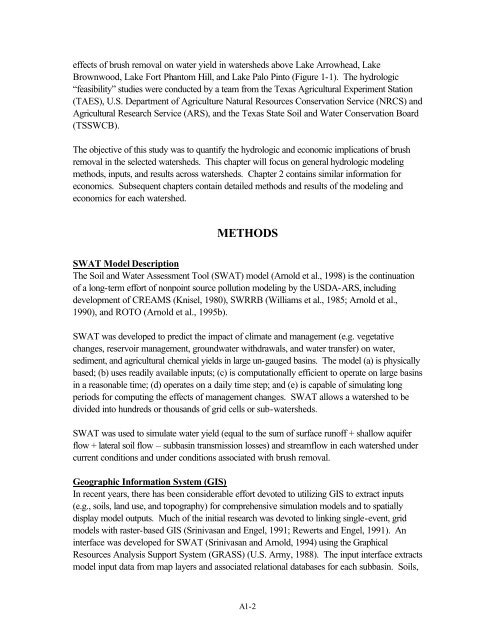Lake Brownwood Watershed - Texas State Soil and Water ...
Lake Brownwood Watershed - Texas State Soil and Water ...
Lake Brownwood Watershed - Texas State Soil and Water ...
You also want an ePaper? Increase the reach of your titles
YUMPU automatically turns print PDFs into web optimized ePapers that Google loves.
effects of brush removal on water yield in watersheds above <strong>Lake</strong> Arrowhead, <strong>Lake</strong><br />
<strong>Brownwood</strong>, <strong>Lake</strong> Fort Phantom Hill, <strong>and</strong> <strong>Lake</strong> Palo Pinto (Figure 1-1). The hydrologic<br />
“feasibility” studies were conducted by a team from the <strong>Texas</strong> Agricultural Experiment Station<br />
(TAES), U.S. Department of Agriculture Natural Resources Conservation Service (NRCS) <strong>and</strong><br />
Agricultural Research Service (ARS), <strong>and</strong> the <strong>Texas</strong> <strong>State</strong> <strong>Soil</strong> <strong>and</strong> <strong>Water</strong> Conservation Board<br />
(TSSWCB).<br />
The objective of this study was to quantify the hydrologic <strong>and</strong> economic implications of brush<br />
removal in the selected watersheds. This chapter will focus on general hydrologic modeling<br />
methods, inputs, <strong>and</strong> results across watersheds. Chapter 2 contains similar information for<br />
economics. Subsequent chapters contain detailed methods <strong>and</strong> results of the modeling <strong>and</strong><br />
economics for each watershed.<br />
METHODS<br />
SWAT Model Description<br />
The <strong>Soil</strong> <strong>and</strong> <strong>Water</strong> Assessment Tool (SWAT) model (Arnold et al., 1998) is the continuation<br />
of a long-term effort of nonpoint source pollution modeling by the USDA-ARS, including<br />
development of CREAMS (Knisel, 1980), SWRRB (Williams et al., 1985; Arnold et al.,<br />
1990), <strong>and</strong> ROTO (Arnold et al., 1995b).<br />
SWAT was developed to predict the impact of climate <strong>and</strong> management (e.g. vegetative<br />
changes, reservoir management, groundwater withdrawals, <strong>and</strong> water transfer) on water,<br />
sediment, <strong>and</strong> agricultural chemical yields in large un-gauged basins. The model (a) is physically<br />
based; (b) uses readily available inputs; (c) is computationally efficient to operate on large basins<br />
in a reasonable time; (d) operates on a daily time step; <strong>and</strong> (e) is capable of simulating long<br />
periods for computing the effects of management changes. SWAT allows a watershed to be<br />
divided into hundreds or thous<strong>and</strong>s of grid cells or sub-watersheds.<br />
SWAT was used to simulate water yield (equal to the sum of surface runoff + shallow aquifer<br />
flow + lateral soil flow – subbasin transmission losses) <strong>and</strong> streamflow in each watershed under<br />
current conditions <strong>and</strong> under conditions associated with brush removal.<br />
Geographic Information System (GIS)<br />
In recent years, there has been considerable effort devoted to utilizing GIS to extract inputs<br />
(e.g., soils, l<strong>and</strong> use, <strong>and</strong> topography) for comprehensive simulation models <strong>and</strong> to spatially<br />
display model outputs. Much of the initial research was devoted to linking single-event, grid<br />
models with raster-based GIS (Srinivasan <strong>and</strong> Engel, 1991; Rewerts <strong>and</strong> Engel, 1991). An<br />
interface was developed for SWAT (Srinivasan <strong>and</strong> Arnold, 1994) using the Graphical<br />
Resources Analysis Support System (GRASS) (U.S. Army, 1988). The input interface extracts<br />
model input data from map layers <strong>and</strong> associated relational databases for each subbasin. <strong>Soil</strong>s,<br />
A1-2



